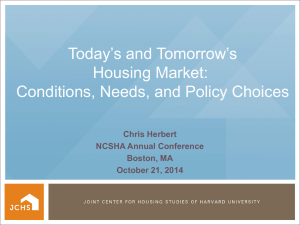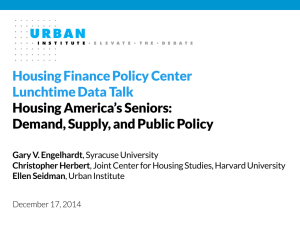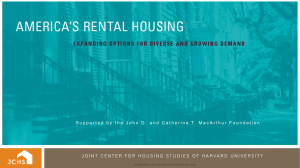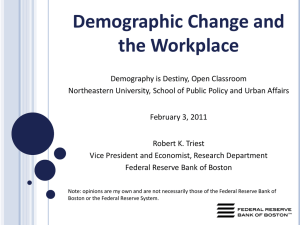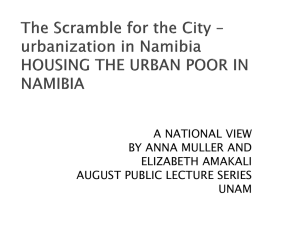Daniel McCue
advertisement
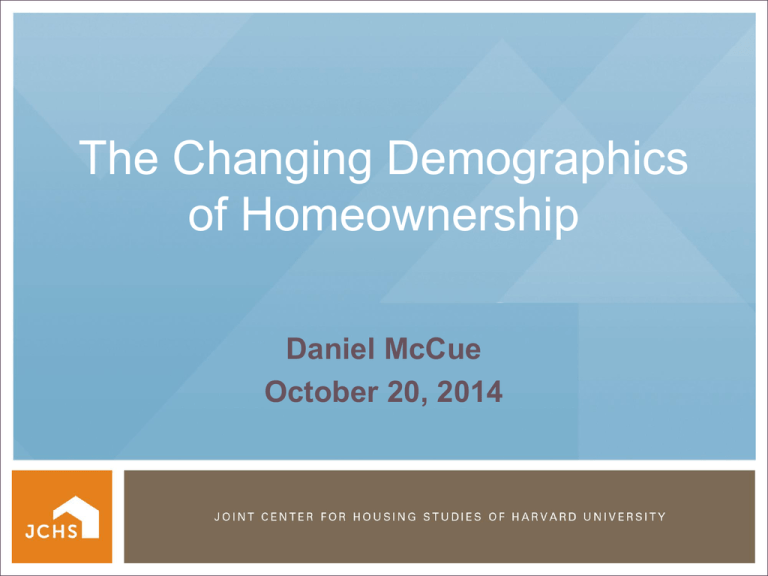
The Changing Demographics of Homeownership Daniel McCue October 20, 2014 © PRESIDENT AND FELLOW S OF HARVARD COLLEGE Homeownership Remains Under Pressure Source: JCHS tabulations of US Census Bureau, Housing Vacancy Surveys. 2 © PRESIDENT AND FELLOW S OF HARVARD COLLEGE Stability Among Older Households Have Prevented an Even Larger Fall-off in the National Homeownership Rate Source: JCHS tabulations of US Census Bureau, Housing Vacancy Survey. © PRESIDENT AND FELLOW S OF HARVARD COLLEGE Homeownership Rate Declines Have Been Uneven Across Household Types Source: JCHS tabulations of US Census Bureau, Current Population Surveys. © PRESIDENT AND FELLOW S OF HARVARD COLLEGE Homeownership Rate Declines Have Also Been Steeper for Minorities Notes: White, black and Asian/other households are non-Hispanic. Hispanic households can be of any race. Source: JCHS tabulations of US Census Bureau, Housing Vacancy Surveys. 5 © PRESIDENT AND FELLOW S OF HARVARD COLLEGE Disproportionate Drops by Race/Ethnicity Have Reversed Gains Made in Reducing Homeownership Rate Gaps Between Whites and Minorities Notes: White and black households are non-Hispanic. Hispanic households may be of any race. Source: JCHS tabulations of US Census Bureau, Housing Vacancy Surveys. 6 © PRESIDENT AND FELLOW S OF HARVARD COLLEGE Minorities Will Account for Three-Quarters of Household Growth Over the Coming Decade Note: White, black, and Asian/other households are non-Hispanic. Hispanic households may be of any race. Sources: JCHS tabulations of US Census Bureau, 2012 American Community Survey; JCHS 2013 middleseries household projections. © PRESIDENT AND FELLOW S OF HARVARD COLLEGE The Older Population Is on Track to Increase Dramatically Population by Age Group (Millions) Source: US Census Bureau, Decennial Censuses and 2012 National Population Projections (middle series). 8 © PRESIDENT AND FELLOW S OF HARVARD COLLEGE By Age 80, Adults Are Far More Likely to Have Disabilities than to Live in Accessible Homes Shares of Housing Units and Population with Disabilities by Age Group (Percent) Notes: Accessibility features specifically include no-step entry, single-floor living, extra-wide hallways and doors, accessible electrical controls and switches, and lever-style handles on doors and faucets. Disabilities include hearing, vision, cognitive, mobility, self-care, and independent living difficulties. Data include only occupied housing units. Source: JCHS tabulations of US Department of Housing and Urban Development, 2011 American Housing Survey, and US Census Bureau, 2012 American Community Survey. 9 © PRESIDENT AND FELLOW S OF HARVARD COLLEGE Trends Behind the Trends © PRESIDENT AND FELLOW S OF HARVARD COLLEGE The Rise and Fall in Homeownership Among Younger Households Mirrors Income Trends 25–34 Year Olds 35–44 Year Olds Note: Incomes are adjusted for inflation by the CPI-U for All Items. Source: JCHS tabulations of US Census Bureau, Housing Vacancy Surveys and Current Population Surveys. 11 © PRESIDENT AND FELLOW S OF HARVARD COLLEGE White-Minority Income Gaps Have Increased for All but the Oldest Age Group Source: JCHS tabulations of US Census Bureau, Current Population Surveys. © PRESIDENT AND FELLOW S OF HARVARD COLLEGE Renter Incomes Have Not Kept Up with Housing Costs Percent Change in Median Value Since 2001 Notes: Values are adjusted for inflation by the CPI-U for All Items. Data exclude renters paying no cash rent. Source: JCHS tabulations of US Census Bureau, American Community Surveys. 13 © PRESIDENT AND FELLOW S OF HARVARD COLLEGE The Share of Renters with Affordability Problems Has Doubled in the Last 50 Years Notes: Rent includes tenant-paid utilities. Moderately (severely) cost-burdened renters pay 30-50% (more than 50%) of pre-tax household income for housing. Renters with zero or negative income are assumed to be severely burdened, while renters not paying cash rent are assumed to be unburdened. Source: JCHS tabulations of US Census Bureau, 1960-2000 Decennial Censuses and 2010 American Community Survey. © PRESIDENT AND FELLOW S OF HARVARD COLLEGE Student Loans Have Driven Up Consumer Debt Burdens Notes: All other consumer debt includes credit card debt, auto loans, retail loans, and personal loans. Annual balances are averages of quarterly data. Source: Federal Reserve Bank of New York, Quarterly Report on Household Debt and Credit, February 2014. © PRESIDENT AND FELLOW S OF HARVARD COLLEGE Financing Constraints Weigh Heavily on Potential Homebuyers Percent of Respondents Source: Fannie Mae National Housing Survey, 2011:Q3. 16 © PRESIDENT AND FELLOW S OF HARVARD COLLEGE Minority and Low-Income Households Are Much More Likely to Be Denied Mortgages Source: JCHS tabulations of 2011 Home Mortgage Disclosure Act data. © PRESIDENT AND FELLOW S OF HARVARD COLLEGE Access to Credit Has Lagged for Minorities and LowerIncome Borrowers Change in First-Lien Loans, 2011–12 (Percent) Notes: White borrowers are non-Hispanic. Hispanic borrowers include only white borrowers of Hispanic origin. Asian/other includes American Indians, Alaska natives, and native Hawaiians and other Pacific Islanders. Data include only first-lien loans to owner-occupants for one- to four-unit properties. Low- (moderate- /middle- / high-) income borrowers have household incomes below 50% (50–79% / 80–119% / 120% or more) of area medians. Source: Neil Bhutta and Glenn B. Canner, Mortgage Market Conditions and Borrower Outcomes: Evidence from the 2012 HMDA Data and Matched HMDA-Credit Record Data, Federal Reserve Bulletin, November 2013. 18 © PRESIDENT AND FELLOW S OF HARVARD COLLEGE Housing is the Major Form of Wealth for Low-Income and Minority Households Median Housing Wealth as a Share of Household Net Worth (Percent) Notes: Data exclude renters and households with zero or negative income. Income quartiles are equal fourths of all households ranked by income. White, black and other households are non-Hispanic; Hispanic households can be of any race. Source: JCHS tabulations of Federal Reserve Board, 2010 Survey of Consumer Finances. © PRESIDENT AND FELLOW S OF HARVARD COLLEGE While Maybe not for their Next Home, the Large Majority of Young Renters Plan to Buy a Home Sometime in the Future Source: Fannie Mae National Housing Survey, 2013 Q4. http://www.fanniemae.com/resources/file/research/housingsurvey/pdf/nhsmay2014presentation.pdf 20 © PRESIDENT AND FELLOW S OF HARVARD COLLEGE Final Points • Homeownership declines have been widespread, but suffered disproportionately across key demographic groups. • Millennials (born 1985-2004) in their 20’s, are the major source of new demand. • They are the largest and most diverse generation ever: – 85-86 million in 2012, relative to 77-78 million baby boomers at similar age in 1972. – Already responsible for 16 million households, will be 40 million by 2025. • Most (nearly all) expect to buy a home in the future, just maybe not their next home. 21 © PRESIDENT AND FELLOW S OF HARVARD COLLEGE
